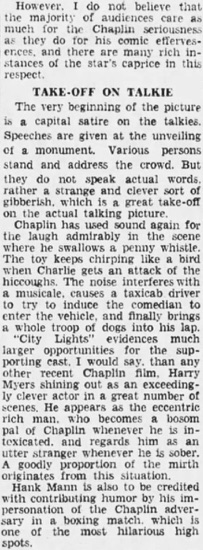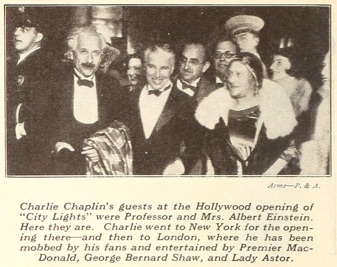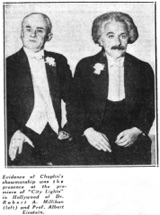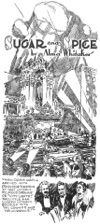City Lights 1930 1931 1932 next previous
City Lights Clippings 185/387
Edwin Schallert, Los Angeles Times, L. A., Cal., Feb. 2, 1931.
Albert Einstein at the „City Lights“ Premiere,
Los Angeles Theatre, Los Angeles, Jan. 30, 1931
& Albert Einstein at the „City Lights“ Premiere,
Los Angeles Theatre, Los Angeles, Jan. 30, 1931
& Albert Einstein and Charles Chaplin at the „City Lights“ Premiere,
Los Angeles Theatre, Los Angeles, Jan. 30, 1931
& SUGAR and SPICE
by Alma Whitaker
„When Charlie Chaplin arrived with Professor Einstein
at that utterly delirious opening of „City Lights,“
the little man looked utterly boggled with the crowds
and the hurrahs!“
(...) Sketch, Los Angeles Times, Feb. 8, 1931
& Evidence of Chaplin‘s showmanship was the presence at the
premiere of „City Lights“ in Hollywood of Dr. Robert A.
Millikan (left) and Prof. Albert Einstein.
(...) Photo, Daily News, N. Y., Feb. 8, 1931
& Charlie Chaplin‘s guests at the Hollywood opening
of „City Lights“ were Professor and Mrs. Albert Einstein. Here
they are. Charlie went to New York for the opening
there – and then to London, where he has been mobbed
by his fans and entertained by Premier MacDonald,
George Bernard Shaw, and Lady Astor.
(...) Photo Acme – P. & A., Screenland, May 1931
& Chaplin Opus Near.
At last the premiere of Charlie Chaplin‘s City Lights
is near. The film will show in the larger cities during the next
few weeks.
The Los Angeles opening was to be a New Year‘s event,
made doubly impressive because booked for a brand-new
$2,000,000 theater, with seats up to $10.
Charlie is said to have spent $1,500,000 on the picture,
which required nearly two years to make.
(...) (...) Hollywood High Lights By Edwin and Elza Schallert,
Picture Play, Feb. 1931
„The comedian stands on a lonely isle“
Editorial content. „PREMIERE JAMS BROADWAY
(Reprinted from Saturday‘s late edition)
By Edwin Schallert“ (...)
„Broadway completely outdid Hollywood Boulevard
last evening. The maddest and most glittering premiere of the
year was held at the new Los Angeles Theater.
Swirling crowds invaded the environs of the show house.
They took possession of the streets in its vicinity
virtually from sidewalk to sidewalk. Traffic became a mad
melee, police charged the throng, cries, shouts and
cheers added to the wild pandemonium. At times even the
microphone through which arriving stars spoke was
threatened with demolition. Some of the spotlights that were
used for illumination actually were smashed.
But despite of all the storm and stress of the occasion
it was a glamorous evening. A throng of stars and other
first-nighters that had come to view the new playhouse and to see
Charlie Chaplin‘s feature comedy, City Lights, nearly three
years in the filming, attested to that. (...)
„FILM REAL NOVELTY
In this decidedly elaborate environment was Chaplin‘s
latest production offered, and doubtless few films
could be described as more of a novelty. For as far as actual
dialogue goes this new feature offers none of it. There
are synchronized score and sound effects, but the spoken word
as such is shunned. No need to relate this, perhaps,
because Chaplin has expressed his views on the subject
more than definitely.
One could scarcely say, of course, that City Lights would
completely alter the present articulate character of
pictures, as some have averred it would. The comedian stands
on a lonely isle in the present hubbub of conservation,
and he can dwell there in serene solitude probably as long
as he wishes because of his pantomimic gifts. That
is, he is one star who can go on without talking, if anyone can, and certainly City Lights goes to show that he knows as of
yore the key that unlocks the way to popular entertainment.
The amusing character of this picture is intriguing.
Even comedy tricks that are not essentially new are employed
with consistent cleverness. The Chaplin capacity to make
folk laugh and laugh uproariously, is preserved with all its uncanny
individuality.
There is more romantic story in City Lights than usual
in a Chaplin film. The love of the blind girl for the
funny man – her idealized impression of him as very wealthy
when he is naught but a tramp – provides a stronger
plot impetus than one generally finds in a Chaplin feature,
and it is amazing how serious the last ten or fifteen
minutes of the production turn out to be as a consequence.
The ending stresses pathos even more strongly
than do Chaplin pictures ordinarily.
However, I do not believe that the majority of audiences
care as much for the Chaplin seriousness as they
do for his comic effervescences, and there are many rich
instances of the star‘s caprice in this respect.
TAKE OFF ON TALKIE
The very beginning of the picture is a capital satire
on the talkies. Speeches are given at the unveiling
of a monument. Various persons stand and address the crowd.
But they do not speak actual words, rather a strange
and clever sort of gibberish, which is a great take-off on the
actual talking picture.
Chaplin has used sound again for the laugh admirably
in the scene where he swallows a penny whistle.
The toy keeps chirping like a bird when Charlie gets
an attack of the hiccoughs. The noise interferes
with a musicale, causes a taxicab driver to try to induce
the comedian to enter the vehicle, and finally brings
a whole troop of dogs into his lap.
City Lights evidences much larger opportunities for the
supporting cast, I would say, than any other recent
Chaplin film. Harry Myers shining out as an exceedingly clever
actor in a great number of scenes. He appears as the
eccentric rich man, who becomes a bosom pal of Chaplin
whenever he is intoxicated, and regards him as an
utter stranger whenever he is sober. A goodly proportion
of the mirth originates from this situation.
Hank Mann is also to be credited with contributing
humor by his impersonation of the Chaplin adversary in a boxing
match, which is one of the most hilarious high spots.“
The world premiere of City Lights takes place in Los Angeles
January 30, 1931 at the Los Angeles Theatre.
Los Angeles Theatre, 615 South Broadway (between
6th and 7th Streets), Los Angeles.
City Lights opens in New York February 6, 1931
at the Cohan Theatre.
George M. Cohan Theatre, 1482 Broadway (between
42nd and 43rd Streets), New York.
Redaktioneller Inhalt
City Lights 1930 1931 1932 next previous








